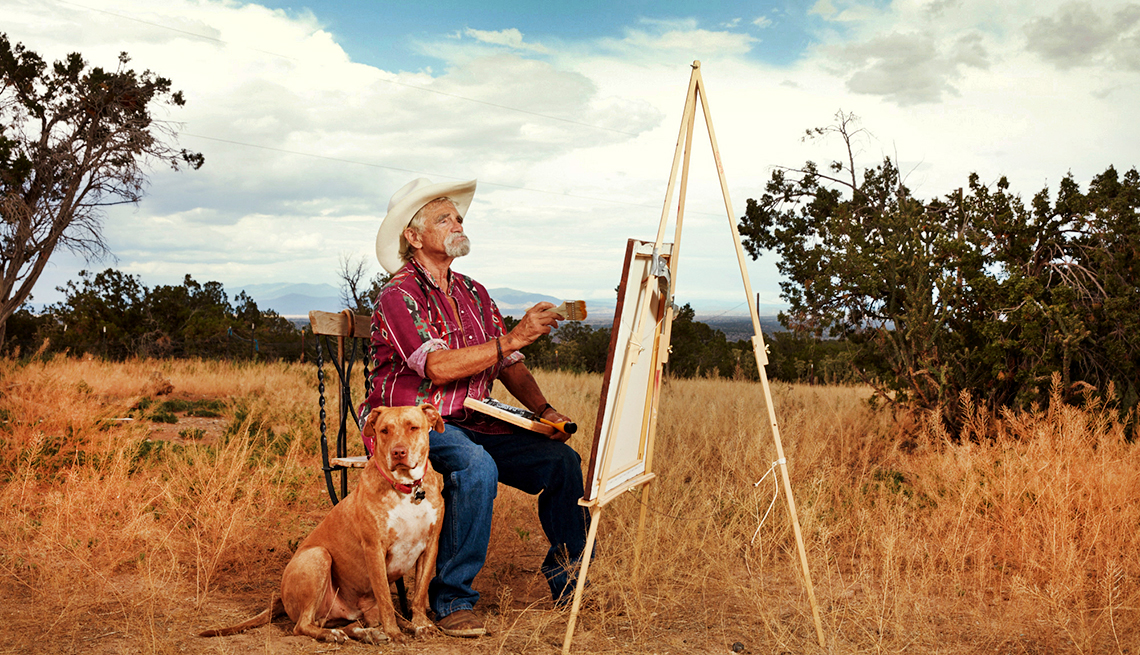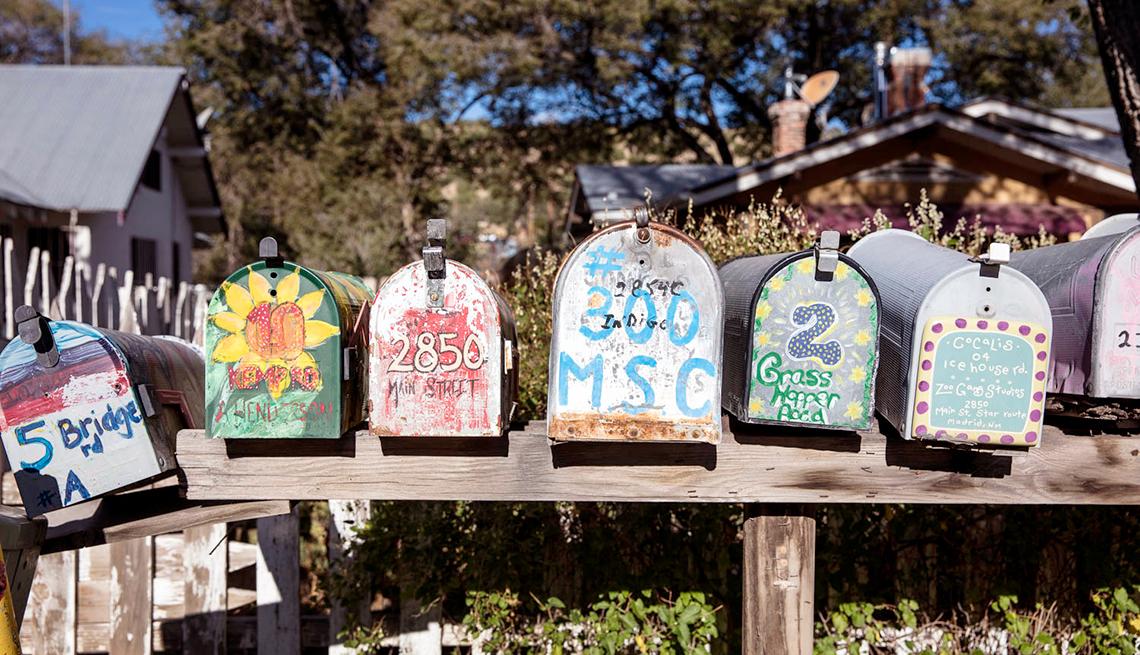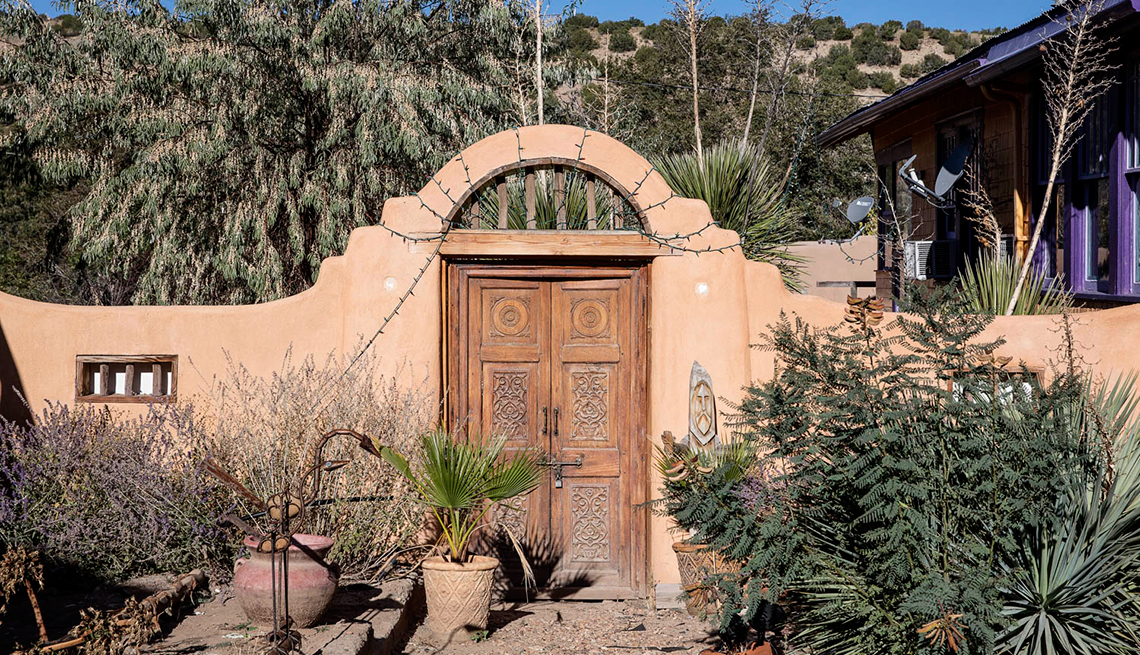Off The Grid in New Mexico
Retirees find solace and beauty in offbeat Madrid
SPEND TIME IN THE DESERT town of Madrid, N.M., and you’ll notice that floating coal dust dirties your clothes even when you’re standing still. There’s no cellphone service. Many homes still have outhouses. And the drinking water smells like hell—literally: It’s full of sulphur from the aquifer below that is honeycombed with coal mines.
“I wouldn’t live anywhere else,” says Barbara Fail, 55, who first visited Madrid 30 years ago and dreamed of returning. Six years ago, she left Manhattan and opened Studio 14, an art gallery on Madrid’s main street. “For me, this is the easiest place in the world. Everyone gets to be themselves. You can live off the grid. People take care of each other. It’s great.”
For most of the 200 or so folks who live within Madrid’s 900 acres (median age: 55) it’s hard to imagine how they’d live anywhere else. Drawn by the town’s mixture of high culture and low cost of living, the area’s population has been slowly growing since the 1970s, when this community took root in an abandoned mining town. Anyone who arrives in Madrid pronouncing its name like the city in Spain will quickly be corrected. “It’s MAD-rid,” says a bearded local in the Mine Shaft Tavern, the town watering hole. “Emphasis on the ‘mad!’ ”
About 120 years ago, this place was willed into existence by a coal company to house mine workers. In the 1950s, the mine closed and the populace fled. Two decades later, the son of the mining company’s owner put the old homes up for sale and rent, and two very different groups moved in: Vietnam War veterans and free-spirited artists and craftspeople.
Now Madrid’s main strip is lined with art galleries and restaurants that cater to day-trippers. Artists and gallery owners live on a grid of dirt streets nearby, in tumbledown homes adorned with outdoor murals and statuary.
On a Wednesday night at the Mine Shaft, Cactus Slim and the Goat Heads tune up on stage as Fail and her partner, Les Reasonover, 62, hold court at a big round table that, over the evening, will attract a number of Madroids, as residents call themselves.
Les has been here for three years after a career at Sandia National Laboratories in Albuquerque, designing microscopic machines for national security applications. His gray beard frames an easy smile, and long hair hangs far beyond his shoulders from beneath a cowboy hat. “I always thought I’d like to live here sometime,” he says. “Then I broke my back in a motorcycle accident. I’m getting paid not to work, and Madrid is a great place to do that.”
Also joining the gathering is Rebecca Nafey, 65, formerly a real estate agent at Madrid’s improbably named Sea Properties, and pottery studio owner Lisa Conley, 61, who’s concerned to see a journalist in town. “60 Minutes reported on us in the 1980s, and we were bombarded with letters from people who wanted to live here,” she recalls. “Several of us had to be a voice of reason and say this is not the kind of place most older people want to come to. You have to be really healthy to live here.”
By necessity, Madrid stitched itself a grassroots safety net: There’s a community garden, a weekly food bank at the volunteer firehouse and fundraisers to help aging Madroids on hard times. Nafey chairs the town’s annual “He/She Bang,” a cross-dressing extravaganza to raise cash for local residents’ emergency medical bills.
Online Community: Join the Conversation - Where do you want to live in retirement?
Ruth Aber, 63, a podiatrist who quit her practice in Connecticut 16 years ago and opened the art gallery Mostly Madrid, says this place is an “intentional community.”
“The purpose of Madrid is to create a community where there is no sense of judgment,” she says. “Vietnam veterans and artists are not two groups who should have been able to sit at the same table. Here, they had no choice.”
Madrid’s war vets tend to disappear when the crowds arrive, and many live well outside of town. But they too rely on the support of the greater community. “Every third Tuesday of the month, most of the veterans who live up in the hills around town get together and have lunch,” says James, a former submarine sailor who prefers not to give his last name. “They just talk and eat and make sure everyone’s still alive.”
Pete Bassin, better known as “Pistol Pete” (because, as he explains unnecessarily, “I always carry a pistol”), is at 77 among the oldest of these rugged individualists. As he tells it, his route to Madrid was circuitous: a childhood on Manhattan’s Park Avenue, a stint in the Army, a career as a stage designer in San Francisco. In 1989 he moved to this spread just outside of Madrid, and five heart attacks and a broken neck (a horse threw him) later he’s still here, living on Social Security in a dirt-floor cabin with a two-tiered interior that resembles an Old West stage set.
Why live out here? Sitting on a hay bale in a shed, Pistol Pete barks. “I’m not gonna die in a hospital! Screw it! I’ll die right here. Or out there. Or if I’m really lucky, I’ll end up in a gunfight.”
The barely marked dirt roads in and around Madrid lend themselves to lots of wrong turns. But if you’re lucky, one of those turns will take you up to the cemetery, on a mesa overlooking town. It’s the place Madroids expect to end up, a final declaration of their independence—and sometimes their interdependence.
Les Reasonover shares a story: “Shortly after I came here, this one fellow died. He was a drifter, kind of a loner. Nobody really liked the old cuss. He never had anything good to say. The county was gonna bury him in an unmarked grave, but around town we started talking, and we said, ‘Well, we didn’t like him, but he was a Madroid.’ He deserved to be buried in our cemetery.”
A team of guys trudged up the hill with shovels and pickaxes to hack out a grave in the rocky soil. It took days. Meanwhile, someone built a coffin. An artist painted a likeness of the fellow on the lid.
“We buried him up there on the mesa,” Reasonover says. “And I thought, If Madroids treat someone they don’t particularly care for like that, what will they do for people they do like?”
Cactus Slim and the Goat Heads finish up their set, and the patrons start to spill out into the star-strewn night.
“That’s what I like about Madroids,” he says. “We’re all here because we’re not all there.”



